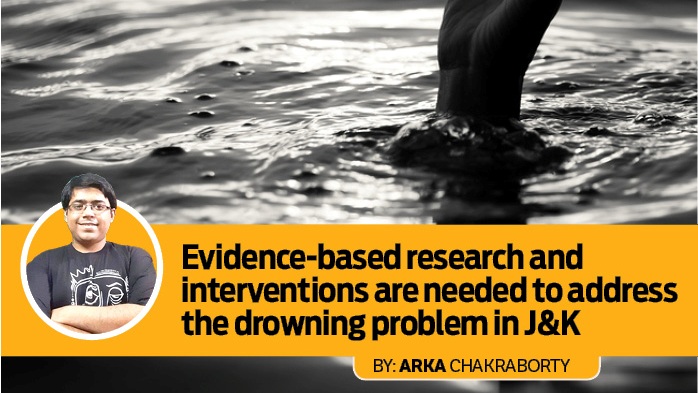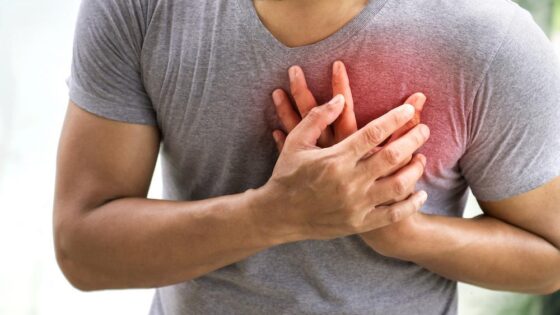This commentary studies the problems and patterns of drowning incidents in Jammu and Kashmir. The factors contributing to deaths by drowning. It offers some important recommendations, for those developing interventions, that may help to alleviate the situation.
ARKA CHAKRABORTY
Jammu and Kashmir is replete with rivers, streams, lakes, ponds, and other water bodies that serve as centers of traditional community life. With most of the region experiencing harsh, snow-bound winters, summer months are certainly a time to warm up and recharge when people of all ages engage in activities generally centered on the water bodies. While some prefer to go on occasional riverside (or lakeside) picnics, for others bathing in open ponds and streams is a part of everyday life. That is not to say everything is always hunky-dory, the summer months in the Union Territory also experience a sharp rise in cases of drowning every year. This is a trend that, in light of some recent cases, can no longer be ignored. The World Health Organization rightly opines that drowning is one of the world’s most “… preventable, neglected and pressing public health issues.” Evidence-based research and interventions are crucial to minimize (if not terminate) this hazard effectively in the long run.
Some recent drowning incidents in J&K: problems and patterns
A news report published on 26th July, 2021 says that the Union Territory of J&K has already had thirty-five cases of drowning this year. Many of those who had drowned were minors (for example, 10-year-old Yawar Manzoor Ganai and 15-year-old Asif Ahmad Khan of Kupwara district, 7-year-old Rabiya Jan of Budgam district, 8-year-old Humara hailing from Uttar Pradesh but deceased in Kupwara district, 3-year-old Mohsin Mushtaq of Bandipora district, 15-year-old Prabh Dayal in Poonch district and 13-year-old Nighat Jan in Anantnag district), but this does not classify the drowning incidents as only a matter of child safety as there are sizable number of cases where adults have drowned – an 80-year old man in Bandipora, a 50-year-old resident of Srinagar and a young social worker Manzoor Raise of Khanabal Kupwara are a few among many. All these cases, if studied along with the structural realities of UT’s geography and demography, will reveal patterns that facilitate such tragic incidents. A few of the factors contributing to these deaths are mentioned below:
Lack of Basic Swimming Skills
A study in 2009 aimed at mapping the lakes and water bodies of J&K using liss III satellite reveals that in Jammu and Kashmir regions, there are 150 and 415 lakes respectively. Although only five rivers of the region are famous (Jhelum, Chenab, Ravi, Sutlej and Indus), there are actually twenty-five major rivers in the UT, let alone the numerous streams that flow through the region. Given the enormity of the number of water bodies present across the UT and the enthusiasm of the people to engage with them in the summer months, it is worrying that only 3% of the region’s population is well-versed in swimming. That means that there is a high chance of those who slip into the water bodies, those who enter the water bodies to bathe or the bystanders who witness people drowning not being swimmers themselves have a high chance of dying of drowning. The September 2014 devasting floods in Kashmir created an urgent necessity to provide swimming lessons to people, especially young men. The help of professional swimmers can be sought by the authorities during the rescue management operations as most areas of Kashmir valley remain vulnerable to flood hazards.
Suicide
According to a report presented by the National Crime Records Bureau, there have been 5943 cases of suicides between 1990 and 2019 in the erstwhile state of Jammu and Kashmir, with the yearly number steadily rising. The annual number of suicides rose from 287 in 2017 to 330 in 2018. Attempts to commit suicide in J&K’s water bodies are, consequently, becoming common. According to the report published by the Kashmir Observer on July 3, 2021 15 people jumped from Sun City’s Cement Noorbagh Bridge within a month. “For the past month,” says Mushtaq Bhat, a local trader, “we’ve been witnessing a dramatic rise in the number of people who jump to their deaths from this bridge. It has become a suicide magnet of sorts with people from various areas coming here to die.” In the face of these suicidal jumps, a unanimous agreement among the locals is that the district administration needs to take this situation seriously and fence off the bridge at the earliest.
Summertime Baths in open water bodies
Given the general lack of swimming skills among J&K’s population, it is strange how many people try to beat the summer heat by taking cold baths in the nearby water bodies. The majority of these risk-takers are teenagers or even younger children who are not fully aware about the dangers these otherwise joyous activities can bring.
Lack of Proper Infrastructure
A basic infrastructural intervention absent in J&K is fencing around water bodies. Most of the region’s lakes and ponds are open, making it more likely for young children to venture into them and drown. According to NBC4 Washington, a four-sided fence around pools can reduce a child’s risk of drowning by 83% compared to a three-sided fence. Unlimited access to water bodies for people (like small children) who are not aware of the dangers that irresponsible engagement with these bodies can bring regularly contributes to avoidable deaths and this needs immediate attention. Malfunctioning infrastructure like damaged bridges can and do contribute to drowning cases/not paying adequate attention to these flaws by the local administration can lead to further deaths.
There is also a palpable lack of equipment such as life jackets, lifebuoys, rescue tubes, shepherd’s crooks, spineboards, reaching poles, first aid kits and the like which can make the act of rescuing a lot easier. Many J&K residents rightly point out that rescuing a drowning person is an extremely difficult task even for experienced swimmers and can lead to the rescuer drowning with the person supposed to be rescued, as happened with Manzoor Raise who died trying to rescue a mother-daughter duo from drowning. These instances can be avoided if the proper rescue equipment are at hand.
Lack of Administrative Alertness
In early July this year, two teenagers – Utba (17) and Insha (19) – drowned in Ferozpur Nallah at Drang in Baramulla district. This was not, however, a case where two irresponsible teenagers ventured into the water. They, according to the report, had done so under adult supervision in what seemed to be perfectly safe conditions to click a few pictures. However, they were swept away by a sudden discharge of water by a Micro Hydal Power Project. No attempt was made by the project employees to alert the unsuspecting people present in or near the Ferozpur Nallah at that time, resulting in the two deaths that day. A siren system is present, but only for the employees. Such a lacklustre administrative system in an area known for tourist presence (Drang) continues to put innocent lives at risk.
Lack of Public Awareness
A lack of public awareness in J&K regarding how to approach water bodies and accidents involving water bodies is already apparent through the above discussion. The shocking dearth of adequate swimming skills and the absence of equipment needed to launch emergency rescue operations at a community level are problems that have already been discussed and can also be classified under a lack of public awareness. The point, however, is driven home by the fact that there is a lack of awareness among the general populace regarding what to do when a person is retrieved from the water while drowning. In most such cases, a lack of knowledge in first aid and related necessities involved in immediately attending to a ‘rescued’ person may lead to ‘dry drowning’ and other such tragic cases. Surely enough, in many cases, the person drowning is rescued from the water body, but due to a lack of the necessary emergency procedures being applied in time, dies by the time he or she is rushed to the hospital. Lack of adult supervision, while young children play near open water bodies, is also indicative of a gross lack of public awareness on water safety.
Recommendations
Given the factors contributing to the tragic drowning incidents that take precious lives every year, it is clear that these tragedies can be minimized through multisectoral, evidence-based and consistent interventions. However, a sustained commitment from the government as well as various non-governmental institutions and the community at large is required to make these interventions effective. Some of the interventions that may help to alleviate the situation are mentioned below.
- As the interventions have to be evidence-based, the government in collaboration with non-governmental organizations should conduct research operations probing deep into the recorded cases of drowning in the region throughout the past few years with questions exploring the age and circumstance of the person drowned, the nature and situation of the water body where the person drowned, whether any infrastructural or administrative mishap contributed to the tragedy etc. The collected data should then be analyzed and measures taken based on this evidence on a priority basis.
- The foremost priority should be protecting the children who cannot perceive the dangers that water bodies can bring. This should be done by completely fencing the open lakes and ponds and installing self-latching gates with latches that young children cannot reach. The information regarding open ponds and lakes is already available in government records, but this information can also be reinforced through public cooperation. As rivers and streams cannot be fenced off, children should be actively discouraged from going near these water bodies without the supervision of an adult who is proficient in swimming.
- Teenagers and adults can be protected through active promotion of public awareness by the government. The UT government’s Department of Disaster Management, Relief, Rehabilitation & Reconstruction has recently issued a public notice delineating some very useful safety tips to be followed while swimming. The contents of this notice have to be publicized using every means necessary (in this case, the assistance of private marketing agencies should also be secured) to maximize its impact in society. Recent government efforts to spread awareness about the Covid-19 crisis have proven its ability to spread public awareness in emergencies. The same level of enthusiasm and commitment should be exhibited while spreading awareness about the more regular public safety hazards such as drowning. A strategy should be drawn up in this regard and should be put into motion in the summer months every year.
- Safety equipment can greatly bolster anti-drowning measures and, if made available to the public institutions, can empower the community to prevent drowning incidents without having to depend on government mechanisms. Safety equipment such as life jackets, lifebuoys, rescue tubes, spineboards, shepherd’s crooks, ring buoys, reaching poles, AEDs, emergency oxygen cylinders and first aid kits should be made available (through partial government expense and assistance, if possible) to accessible public buildings (like mosques, temples, the home of the village chiefs, the panchayat buildings or any such buildings near water bodies) under the supervision of locally recognizable public figures of authority. These public figures (or some other locally recognizable people like social workers) should be trained in the use of such equipment. This will go a long way in increasing the efficiency of locally organized rescue operations where government agencies cannot reach in time.
- Currently, the most crucial way to empower the general populace of J&K against drowning is to actively disseminate among them the knowledge of swimming. The fact that only 3% of the population knows how to swim makes the present recommendation a great priority. The assistance of educational institutions and institutions devoted specifically to swimming such as the Swimming and Surviving Society must be secured and utilized in this regard.
Conclusion
The fact that as many as thirty-five people have drowned so far this summer in Jammu and Kashmir should be alarming enough for the government and the society at large to spring into action, as almost every death by drowning can easily be avoided by employing a few easy safety measures. The UT government has already taken the first step towards a safer public relationship with the region’s water bodies by issuing a timely public notice. This move should be taken as the first step towards a long evidence-based and multi-sectoral process demanding commitment and enthusiasm from all sections of society. Only through consistent engagement with the multi-layered challenge can we make sure that no more innocent lives are lost to J&K’s beautiful yet dangerous rivers and lakes.
The author is Junior Fellow at Jammu and Kashmir Policy Institute
References
- Anonymous. “Two Minor Boys Drown in Ponds in North Kashmir’s Kupwara.” Kashmir Observer. July 12, 2021. https://m.kashmirobserver.net/2021/07/12/two-minor-boys-drown-in-ponds-in-north-kashmirs-kupwara/amp/ (accessed: August 5, 2021)
- Anonymous. “Body of Srinagar Resident Fished out from Jhelum after Eight Days.” Kashmir Life. July 8, 2021. https://kashmirlife.net/body-of-srinagar-resident-fished-out-from-jhelum-after-eight-days-271852/amp/ (accessed: August 5, 2021)
- Anonymous. “Minor Girl Slips into Stream, Dies.” Kashmir Life. June 28, 2021. https://kashmirlife.net/minor-girl-slips-into-stream-dies-271119/ (accessed: August 6, 2021)
- Anonymous. “Minor Drowns in Kupwara.” Kashmir Life. March 2, 2021. https://kashmirlife.net/minor-drowns-in-kupwara-260987/ (accessed: August 6, 2021)
- Anonymous. “Minor Boy Dies after Drowning in Pond.” Kashmir Life. February 14, 2021. https://kashmirlife.net/minor-boy-dies-after-drowning-in-pond-259842/ (accessed: August 6, 2021)
- Anonymous. “Teenager Drowns to Death.” Kashmir Life. June 11, 2021. https://kashmirlife.net/teenager-drowns-to-death-269753 (accessed: August 6, 2021)
- Anonymous. “Drowned on June 16, Bijbehara Girl’s Body Fished out from River Jhelum.” Kashmir Life. September 28, 2020. https://kashmirlife.net/bijbehara-girls-body-fished-out-from-river-jhelum-247612/ (accessed: August 6, 2021)
- Anonymous. “SDRF team rescues youth from Chenab river, minor drowns.” State Times. July 02, 2021. https://web.statetimes.in/sdrf-team-rescues-youth-from-chenab-river-minor-drowns/ (accessed: August 6, 2021)
- Waseem, Peerzada. “Two cousin sisters drown to death as picnic trip turns into nightmaire for Sgr family | KNO.” Kashmir News Observer. July 14, 2021. https://www.kashmirnewsobserver.com/top-stories/two-cousin-sisters-drown-to-death-as-picnic-trip-turns-into-nightmaire-for-sgr-family-kno-88872 (accessed: August 7, 2021)
- Anonymous. “Bandipora: Elderly man slips into Jhelum, dies.” Rising Kashmir. July 15, 2021. https://www.riingkashmir.com/displaynews.aspx?news=70066 (accessed: August 7, 2021)
- “PUBLIC NOTICE: Safety Tips to be followed while swimming.” Government of Jammu and Kashmir. J&K State Emergency Operation Center, Department of Disaster Management, Relief, Rehabilitation & Reconstruction. Dated: July 14, 2021.
- Nasim, Hanifa and Tasneem Keng. Directory of Lakes and Waterbodies of J&K State: Using Remote Sensing & GTS Technology. Srinagar: Department of Environment and Remote Sensing, 2012.
- Anonymous. Preventing drowning: an implementation guide. Spain: World Health Organization, 2017.
- Veelzke, Margaret. “15 Ways to Help Prevent Drowning This Summer.” NBC4 Washington. June 17, 2014. https://www.nbcwashington.com/news/local/drowning-swimming-drown-water-pool-beach-15-things-you-need-to-know-this-summer-about-the-fifth-leading-cause-of-death/1969764/ (accessed: August 5, 2021)
- Andrabi, Aaqid. ‘15 Jumps in 30 Days’: This Kashmir Area Is Bearing Brunt of Suicides. Juy, 3, 2021 https://kashmirobserver.net/2021/07/03/15-jumps-in-30-days-this-kashmir-area-is-bearing-brunt-of-suicides/








Leave a Reply
You must belogged in to post a comment.